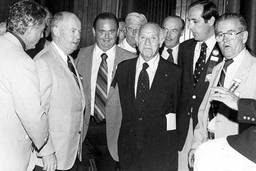There were some nice highs at the AFL-CIO convention this month — visits by President Obama, Labor Secretary Hilda Solis, and Caroline Kennedy, re-entry into the Federation by UNITE/HERE.
But there were some low lows — too many older white males dominating the podium with too much vulgar language (not good for a union movement wanting to appeal to younger, female and minority workers).
But the maximum lifts for me were the Diversity Conference on Sunday, the announcement that fully 43 percent of the convention delegates were women and/or minorities, and those same old white guys standing tall for equal union rights for Lesbian/Gay/Bisexual/Transgender (LGBT) members.
During the friendly debate over a diversity resolution, so many beefy white guys were jumping up and testifying for “diversity, full inclusion and participation” that I first wondered if they thought LGBT was an acronym for “ladies’ garments being torn.”
But it became apparent that 14 years of leadership by John Sweeney had produced a significant advancement over bigotry and discrimination. When Sweeney told a Diversity Conference earlier in the week that “no worker should ever again have to enter through the back door to the house of labor,” the delegates jumped out of their seats.
Elizabeth Bunn, the eloquent secretary-treasurer of the United Auto Workers called him “our quiet lion” in the movement to elevate women, minority, youth, LGTB and disabled members into union leadership positions.
The new team elected to continue Sweeney’s work over the next four years reinforced the notion that “this is not your father’s union movement.” Arlene Holt-Baker, who was re-elected executive vice president, is a black woman. The new secretary-treasurer is Liz Shuler, at 39 the youngest person ever elected to one of the top AFL-CIO offices.
And Rich Trumka, who moved up from the second slot to the top spot, isn’t your average burly coal miner — during the presidential campaign last fall, he challenged union members across the rustbelt not to give in to their worst instincts by voting against Obama because he was black.
And in his acceptance speech to the convention Trumka roared, “What does labor want? We want a nation where it doesn’t matter what the color of your skin is, or what sex or religion you are, or whether you’re gay or straight, or what country your family’s from because here in America, we believe everyone ought to have their chance to step into the winner’s circle.”
The progress made by the AFL-CIO proved you can win the battle against bigotry if you work at it. When Sweeney took office in 1995, the AFL-CIO was practicing it’s own versions of “don’t ask, don’t tell,” and “separate but equal,” and there were only two women and no blacks on its governing executive council.
Sweeney increased the size of the council and named women, minorities and LGBTs to the new spots, then instituted new preferential hiring and promotion standards at AFL-CIO headquarters in Washington and in its hundreds of state and local labor federations across the country. In 2005, he pushed for the passage of an official convention resolution that set out firm goals and set quotas for affiliates and state and local bodies, a splendid statement of affirmative action.
The new AFL-CIO executive council elected in Pittsburgh includes 12 women (two of whom are gay), three latinos, and seven African-American men. That adds up to not quite 50 percent, not enough, but it’s a helluva lot less “male, pale and stale” than the U.S. Congress, or, for that matter, the U.S. Supreme Court.
(Check out all the speeches referenced here.)
This article originally appeared at Ray Abernathy’s blog, From the Left Bank of the Potomac.







